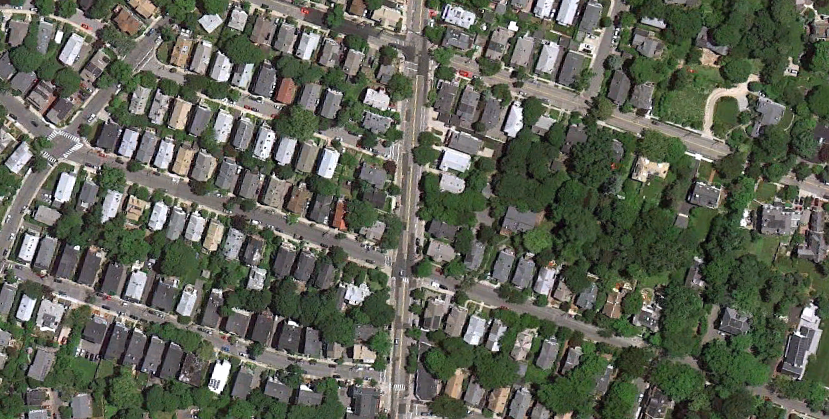
Mimicking nature is nothing new for human beings. Ceremonial dress and dances have long imitated totemic animals. Leonardo da Vinci’s plans for a flying machine were closely modeled on the birds he saw out his window. And more recently, nature has inspired designers of everything from velcro to solar cell installations.
Cities and suburbs would seem to be an exception to that rule. They are arguably anthropogenic down to the last blade of grass. We pile dirt up and grade it down, plant grass and pull it from sidewalk cracks. But like other human endeavors, urban areas unwittingly imitate natural landscapes. Or more accurately, people tend to mimic each other, which in turn makes urban landscapes mimic natural ones.
Ecosystems are clumpy. They aren’t randomly distributed in small bits so much as they are consolidated into large associations—think forests, prairies, and so on.¹ It stands to reason that when people move in, the clumpiness of nature moves out. After all, yards are managed by individuals, each with their own tastes and preferences. Just because Sally plants a shrub doesn’t mean George will. But in reality, we’re not so creative. If Sally does plant a shrub, George is more likely to follow suit and so are the other neighbors. Thusly, neighborhoods take on specific ecological forms—a shrubland in this case.
The spatial contagion of landscaping was first demonstrated by two studies of the Hochelaga-Maisonneuve district in Montreal. Hochelaga-Maisonneuve is an old neighborhood that dates back to the mid-19th century and is complete with residential, commercial, and industrial zones, though most of the current houses were built between the end of World War II and 1970. Researchers drove up and down 17 streets, recording the spatial and floral characteristics of 646 front yards.
They discovered that the distance between two yards was responsible for 20 percent of the variation between them. In other words, next door neighbors are more likely to have similar landscaping than people three blocks apart. Next door neighbors were also more likely to have more similar vegetation than houses across the street from one another.² Lastly, the shape and size of the yard also drove landscaping choices. Together, they created a neighborhood that, when examined spatially, exhibited some of the same clumpy characteristics of natural ecosystems.
The reason, the researchers think, is because most of us tend to be pretty unoriginal when it comes to aesthetic decisions. They trot out the works of 19th century American philosopher Charles Sanders Pierce to support their case.³ Pierce proposed that there is no truth, only knowledge filtered by interpretation. In other words, one person’s knowledge is merely an interpretation of another person’s knowledge. Building on that, Pierce surmised that there were three types of human experience, which he cleverly called firstness, secondness, and thirdness. Firstness deals with sensory perceptions—smell, taste, touch, and so on. Secondness connects those sensory perceptions to another bit of information, say associating a smell with the type of flower, for example. Thirdness goes further, establishing symbolic links between two otherwise unrelated pieces of information, like the crunch of leaves underfoot and the beginning of the school year. Loosely, Pierce’s three levels of experience correspond with feeling, knowing, and understanding.
Most people in a neighborhood experience front yards on a primary or secondary level, the researchers suggest. People may take a neighbor’s landscaping and reproduce it wholesale—a primary interpretation—or add a little twist like planting a different variety—a secondary interpretation. Rare are the people who come up with entirely new ideas, the people who produce tertiary interpretations. Not all tertiary interpretations catch on—if a design is too daring, neighbors won’t mimic it—but those that do change the neighborhood. These people are the germs of spatial contagion in cities. Their creativity can begin a cascade of ecological change within cities.
Tertiary interpreters make urban ecosystems fundamentally different from other ecosystems—they have agency, unlike many other processes—yet strikingly similar—they are disturbances, like fires, hurricanes, and floods. They can drive widespread change like a giant forest fire or be confined to a yard like a small tree-fall gap in a forest. But no matter their scale, creative people are a distinct type of disturbance and one unique to urban ecosystems.
- While it’s true that our scale of perception is partly responsible—after all, we don’t consider a small patch of grass a prairie, though both contain grasses—there’s functional support for the distinctions between ecosystems. ↩
- Across-the-street neighbors’ landscaping is more “in your face”, and so people strive to differentiate themselves more, the authors suspect. ↩
- This is where things get heavy, man. ↩
Sources:
Julien, M., & Zmyslony, J. (2001). Why Do Landscape Clusters Emerge in an Organized Fashion in Anthropogenic Environments? Landscape Research, 26 (4), 337-350 DOI: 10.1080/01426390120090139
Jean Zmyslony, & Daniel Gagnon (1998). Residential management of urban front-yard landscape: A random process? Landscape and Urban Planning, 40 (4), 295-307 DOI: 10.1016/S0169-2046(97)00090-X
Jean Zmyslony, & Daniel Gagnon (2000). Path analysis of spatial predictors of front-yard landscape in an anthropogenic environment Landscape Ecology, 15, 357-371
Photo from Google Earth.
Related posts:
An ecology of gardens and yards